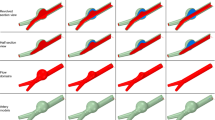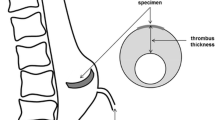Abstract
In this paper, we study the correlation between the wall shear stress, a hemodynamical index derived from numerical simulations, and an new index MFA-ILT for the characterization of intraluminal thrombus (ILT) in the presence of abdominal aortic aneurysms. Based on the processing of medical images, we define our index MFA-ILT by projecting onto lumen surface a measure of the ILT thickness. From the physical point of view, hemodynamical indexes describe the mechanical stimuli at which the luminal surface of the vessel wall is subject to, due to blood flow. Specifically, we consider the time-averaged wall shear stress and the oscillatory shear index. The first index provides a measurement of the averaged magnitude of the shear stress; the second index measures the rate of change of shear stress. To reconstruct the hemodynamical indexes, we build in silico three-dimensional models. We use the same physical parameters and boundary conditions for all the aneurysms in the sample. The computer simulations do not require any additional invasive patient examination. We consider eleven cases of abdominal aortic aneurysms spanning a wide range of different morphological features. All the cases are characterized by a thin intraluminal thrombus. We can, therefore, assume that the lumen we currently observe does not significantly differ from the one before the thrombus deposition. Our results suggest that the value of wall shear stresses and intraluminal thrombus deposition are correlated. Moreover, we conclude that in six cases time-averaged wall shear stress provides a preliminary indication of the area at risk of thrombus deposition.














Similar content being viewed by others
References
Aggarwal S, Qamar A, Sharma V, Sharma A (2011) Abdominal aortic aneurysm: a comprehensive review. Exp Clin Cardiol 16(1):11–15
Airhart N, Curci J (2014) Arterial aneurysms. In: Cronenwett JJK (ed) Rutherford’s vascular surgery, chapter 9, 8th edn. Elsevier Saunders, Philadelphia
Antiga L, Piccinelli M, Botti L, Ene-Iordache B, Remuzzi A, Steinman DA (2008) An image-based modeling framework for patient-specific computational hemodynamics. Med Biol Eng Comput 46(11):1097. https://doi.org/10.1007/s11517-008-0420-1
Arzani A, Suh GY, Dalman RL, Shadden SC (2014) A longitudinal comparison of hemodynamics and intraluminal thrombus deposition in abdominal aortic aneurysms. Am J Physiol Heart Circ Physiol 307(12):H1786–H1795. https://doi.org/10.1152/ajpheart.00461.2014 PMID: 25326533
Assar AN, Zarins CK (2009) Ruptured abdominal aortic aneurysm: a surgical emergency with many clinical presentations. Postgrad Med J 85(1003):268–273. https://doi.org/10.1136/pgmj.2008.074666
Ayachit U (2015) The paraview guide: a parallel visualization application. Kitware. ISBN: 978-1930934306
Bazilevs Y, Hsu MC, Zhang Y, Wang W, Liang X, Kvamsdal T, Brekken R, Isaksen JG (2010) A fully-coupled fluid–structure interaction simulation of cerebral aneurysms. Comput Mech 46(1):3–16. https://doi.org/10.1007/s00466-009-0421-4
Bertagna L, Deparis S, Formaggia L, Forti D, Veneziani A (2017) The LifeV library: engineering mathematics beyond the proof of concept. arXiv e-prints
Bhagavan D, Di Achille P, Humphrey JD (2018) Strongly coupled morphological features of aortic aneurysms drive intraluminal thrombus. Sci Rep. https://doi.org/10.1038/s41598-018-31637-6
Boyd AJ, Kuhn DCS, Lozowy RJ, Kulbisky GP (2016) Low wall shear stress predominates at sites of abdominal aortic aneurysm rupture. J Vasc Surg 63(6):1613–1619. https://doi.org/10.1016/j.jvs.2015.01.040
Chaikof E et al (2018a) The society for vascular surgery practice guidelines on the care of patients with an abdominal aortic aneurysm. J Vasc Surg 67(1):2–77. https://doi.org/10.1016/j.jvs.2017.10.044
Chaikof EL, Dalman RL, Eskandari MK, Jackson BM, Lee WA, Mansour MA, Mastracci TM, Mell M, Murad MH, Nguyen LL, Oderich GS, Patel MS, Schermerhorn ML, Starnes BW (2018b) The society for vascular surgery practice guidelines on the care of patients with an abdominal aortic aneurysm. J Vasc Surg 67(1):2–77.e2. https://doi.org/10.1016/j.jvs.2017.10.044
Colciago CM, Deparis S, Quarteroni A (2014) Comparisons between reduced order models and full 3D models for fluid-structure interaction problems in haemodynamics. J Comput Appl Math 65:120–138. https://doi.org/10.1016/j.cam.2013.09.049
Colciago CM, Forti D, Deparis S (2017) Fluid–structure interaction for vascular flows: from supercomputers to laptops. In: Frei S, Holm B, Richter T, Wick T, Yang H (eds) Fluid–structure interaction. Modeling, adaptive discretisations and solvers, Radon Series on computational and applied mathematics, vol 20. De Gruyter, Berlin, pp 237–282
Darling RC, Messina CR, Brewster DC, Ottinger LW (1977) Autopsy study of unoperated abdominal aortic aneurysms, the case for early resection. Circulation 56(3):II161–II164
Di Achille P, Tellides G, Figueroa CA, Humphrey JD (2014) A haemodynamic predictor of intraluminal thrombus formation in abdominal aortic aneurysms. Proc R Soc A Math Phys Eng Sci. https://doi.org/10.1098/rspa.2014.0163
Di Achille P, Tellides G, Humphrey JD (2016) Hemodynamics-driven deposition of intraluminal thrombus in abdominal aortic aneurysms. Int J Numer Methods Biomed Eng. https://doi.org/10.1002/cnm.2828
Dryjski M, Driscoll JL, Blair RC, McGurrin MA, Dagher FJ, Ceraolo MJ, O’Donnell Blackshear WMJ (1994) The small abdominal aortic aneurysm: the eternal dilemma. J Cardiovasc Surg (Torino) 35(2):95–100
Dua MM, Dalman RL (2010) Hemodynamic influences on abdominal aortic aneurysm disease: application of biomechanics to aneurysm pathophysiology. Vasc Pharmacol 53(1–2):11–21. https://doi.org/10.1016/j.vph.2010.03.004
EPFL, MOXOFF, UNIMI, YOTTACLE (2017) aXurge: the ultimate platform that supports vascular specialists, surgeons and evar device specialists in the treatment of abdominal aortic aneurysms. www.axurge.com
Faggiano E, Formaggia F, Antiga L (2013) An open-source tool for patient-specific fluid–structure vessel mesh generation. In: Modelling of physiological flows (MPF)
Fedele M, Faggiano E, Barbarotta L, Cremonesi F, Formaggia L, Perotto S (2015) Semi-automatic three-dimensional vessel segmentation using a connected component localization of the region-scalable fitting energy. In: 2015 9th international symposium on image and signal processing and analysis (ISPA), pp 72–77. https://doi.org/10.1109/ISPA.2015.7306035
Figueroa CA, Vignon-Clementel IE, Jansen KE, Hughes TJ, Taylor CA (2006) A coupled momentum method for modeling blood flow in three-dimensional deformable arteries. Comput Methods Appl Mech Eng 195(41):5685–5706. https://doi.org/10.1016/j.cma.2005.11.011 John H. Argyris Memorial Issue. Part II
Fillinger MF, Marra SP, Raghavan ML, Kennedy FE (2003) Prediction of rupture risk in abdominal aortic aneurysm during observation: wall stress versus diameter. J Vasc Surg 37(4):724–732. https://doi.org/10.1067/mva.2003.213
Finol EA, Amon CH (2001) Blood flow in abdominal aortic aneurysms: pulsatile flow hemodynamics. J Biomech Eng 123(5):474–484. https://doi.org/10.1115/1.1395573
Finol EA, Keyhani K, Amon CH (2003) The effect of asymmetry in abdominal aortic aneurysms under physiologically realistic pulsatile flow conditions. J Biomech Eng 125(2):207–217. https://doi.org/10.1115/1.1543991
Formaggia L, Quarteroni A, Veneziani A (2009) Cardiovascular mathematics. Modeling, simulation and applications. Springer, Berlin
Gadowski GR, Pilcher DB, Ricci MA (2006) Abdominal aortic aneurysm expansion rate: effect of size and beta-adrenergic blockade. J Vasc Surg 19(4):727–731. https://doi.org/10.1016/S0741-5214(94)70048-6
Geroulakos G, Nicolaides A (1992) Infrarenal abdominal aortic aneurysms less than five centimetres in diameter: the surgeon’s dilemma. Eur J Vasc Surg 6(6):616–622
Heilmaier C, Moysidis T, Weishaupt D, Kroger K (2014) Calcification in smaller and larger infrarenal aneurysmatic abdominal aortas-differences in plaque patterns. Angiology 2(2):1–5. https://doi.org/10.4172/2329-9495.1000129
Joly F, Soulez G, Garcia D, Lessard S, Kauffmann C (2018) Flow stagnation volume and abdominal aortic aneurysm growth: insights from patient-specific computational flow dynamics of Lagrangian-coherent structures. Comput Biol Med 92:98–109. https://doi.org/10.1016/j.compbiomed.2017.10.033
Kazi M, Thyberg J, Religa P, Roy J, Eriksson P, Hedin U, Swedenborg J (2003) Influence of intraluminal thrombus on structural and cellular composition of abdominal aortic aneurysm wall. J Vasc Surg 38(6):1283–1292. https://doi.org/10.1016/S0741-5214(03)00791-2
Les AS, Shadden SC, Figueroa CA, Park JM, Tedesco MM, Herfkens RJ, Dalman RL, Taylor CA (2010) Quantification of hemodynamics in abdominal aortic aneurysms during rest and exercise using magnetic resonance imaging and computational fluid dynamics. Ann Biomed Eng 38(4):1288–1313. https://doi.org/10.1007/s10439-010-9949-x
Lozowy R, Kuhn D, Ducas A, Boyd A (2017) The relationship between pulsatile flow impingement and intraluminal thrombus deposition in abdominal aortic aneurysms. Cardiovasc Eng Technol 8(1):57
Martino ESD, Bohra A, Geest JPV, Gupta N, Makaroun MS, Vorp DA (2006) Biomechanical properties of ruptured versus electively repaired abdominal aortic aneurysm wall tissue. J Vasc Surg 43(3):570–576. https://doi.org/10.1016/j.jvs.2005.10.072
Metaxa E, Tzirakis K, Kontopodis N, Ioannou CV, Papaharilaou Y (2018) Correlation of intraluminal thrombus deposition, biomechanics, and hemodynamics with surface growth and rupture in abdominal aortic aneurysm-application in a clinical paradigm. Ann Vasc Surg 46:357–366. https://doi.org/10.1016/j.avsg.2017.08.007
Nichols WW, O’Rourke M (1998) McDonald’s blood flow in arteries—theoretical, experimental and clinical principles, 6th edn. Hodder Arnold, London
Nobile F, Vergara C (2008) An effective fluid–structure interaction formulation for vascular dynamics by generalized Robin conditions. SIAM J Sci Comput 30(2):731–763. https://doi.org/10.1137/060678439
Patel MI, Hardman DT, Fisher CM, Appleberg M (1995) Current views on the pathogenesis of abdominal aortic aneurysms. J Am Coll Surg 181:371–382
Piccinelli M, Vergara C, Antiga L, Forzenigo L, Biondetti P, Domanin M (2013) Impact of hemodynamics on lumen boundary displacements in abdominal aortic aneurysms by means of dynamic computed tomography and computational fluid dynamics. Biomech Model Mechanobiol 12(6):1263–1276. https://doi.org/10.1007/s10237-013-0480-5
Quarteroni A (2017) Numerical modeling of differential problems, 3rd edn. Springer, Berlin
Quarteroni A, Valli A (2008) Numerical approximation of partial differential equations. Springer series in computational mathematics. Springer, Berlin
Shum J, Martufi G, Di Martino E, Washington CB, Grisafi J, Muluk SC, Finol EA (2011) Quantitative assessment of abdominal aortic aneurysm geometry. Ann Biomed Eng 39(1):277–286. https://doi.org/10.1007/s10439-010-0175-3
The MathWorks Inc (2015b) Natick, Massachussets, United States: Matlab
Vande Geest JP, Wang DHJ, Wisniewski SR, Makaroun MS, Vorp DA (2006) Towards a noninvasive method for determination of patient-specific wall strength distribution in abdominal aortic aneurysms. Ann Biomed Eng 34(7):1098–1106. https://doi.org/10.1007/s10439-006-9132-6
Vergara C, Van D L, Quadrio M, Domanin M (2017) Large eddy simulations of blood dynamics in abdominal aortic aneurysms. Med Eng Phys in press
Virag L, Wilson JS, Humphrey JD, Karšaj I (2015) A computational model of biochemomechanical effects of intraluminal thrombus on the enlargement of abdominal aortic aneurysms. Ann Biomed Eng 43(12):2852–2867. https://doi.org/10.1007/s10439-015-1354-z
Vorp DA (2007) Biomechanics of abdominal aortic aneurysm. J Biomech 40(9):1887–1902. https://doi.org/10.1016/j.jbiomech.2006.09.003
Vorp DA, Wang DHJ, Webster MW, Federspiel WJ (1998) Effect of intraluminal thrombus thickness and bulge diameter on the oxygen diffusion in abdominal aortic aneurysm. J Biomech Eng 120(5):579–583. https://doi.org/10.1115/1.2834747
Vorp DA, Lee PC, Wang DH, Makaroun MS, Nemoto EM, Ogawa S, Webster MW (2001a) Association of intraluminal thrombus in abdominal aortic aneurysm with local hypoxia and wall weakening. J Vasc Surg 34(2):291–299. https://doi.org/10.1067/mva.2001.114813
Vorp DA, Lee PC, Wang DH, Makaroun MS, Nemoto EM, Ogawa S, Webster MW (2001b) Association of intraluminal thrombus in abdominal aortic aneurysm with local hypoxia and wall weakening. J Vasc Surg 34(2):291–299. https://doi.org/10.1067/mva.2001.114813
Wang DHJ, Makaroun MS, Webster MW, Vorp DA (2002) Effect of intraluminal thrombus on wall stress in patient-specific models of abdominal aortic aneurysm. J Vasc Surg 36(3):598–604
Acknowledgements
We thank the reviewers the careful reading and the constructive discussions. We gratefully acknowledge the CSCS for providing us the CPU resources under Project ID s635 and s796. Part of this work has been developed in the context of ERC Proof of Concept Grant MATH4AAARISK and of the FNS Project 200021E-168311, Domain-Decomposition-Based Fluid Structure Interaction Algorithms for Highly Nonlinear and Anisotropic Elastic Arterial Wall Models in 3D. The geometries considered in this study are taken from fully anonymous patients, named \(\hbox {AAA}_1\) to \(\hbox {AAA}_{11}\), as approved by the Ethical committee of the Fondazione IRCCS Ca’ Granda - Ospedale Maggiore Policlinico (Aut. 2373 12th April 2013).
Funding
This study was funded by ERC-PoC (Grant Number 680420) and FNS (Grant 200021E-168311).
Author information
Authors and Affiliations
Corresponding author
Ethics declarations
Conflict of interest
Chiara Riccobene and Elisa Schenone are employee of the company MOXOFF; Alfio Quarteroni is co-founder and President of MOXOFF.
Additional information
Publisher's Note
Springer Nature remains neutral with regard to jurisdictional claims in published maps and institutional affiliations.
Rights and permissions
About this article
Cite this article
Colciago, C.M., Deparis, S., Domanin, M. et al. Analysis of morphological and hemodynamical indexes in abdominal aortic aneurysms as preliminary indicators of intraluminal thrombus deposition. Biomech Model Mechanobiol 19, 1035–1053 (2020). https://doi.org/10.1007/s10237-019-01269-4
Received:
Accepted:
Published:
Issue Date:
DOI: https://doi.org/10.1007/s10237-019-01269-4




